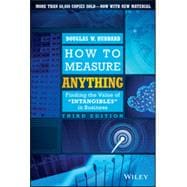This insightful and eloquent book will show you how to measure those things in your own business, government agency or other organization that, until now, you may have considered "immeasurable," including customer satisfaction, organizational flexibility, technology risk, and technology ROI.
- Adds new measurement methods, showing how they can be applied to a variety of areas such as risk management and customer satisfaction
- Simplifies overall content while still making the more technical applications available to those readers who want to dig deeper
- Continues to boldly assert that any perception of "immeasurability" is based on certain popular misconceptions about measurement and measurement methods
- Shows the common reasoning for calling something immeasurable, and sets out to correct those ideas
- Offers practical methods for measuring a variety of "intangibles"
- Provides an online database (www.howtomeasureanything.com) of downloadable, practical examples worked out in detailed spreadsheets
Written by recognized expert Douglas Hubbard—creator of Applied Information Economics—How to Measure Anything, Third Edition illustrates how the author has used his approach across various industries and how any problem, no matter how difficult, ill defined, or uncertain can lend itself to measurement using proven methods.








